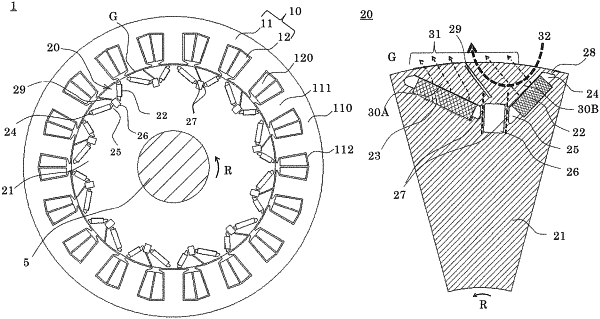| CPC H02K 1/2766 (2013.01) [H02K 1/2791 (2022.01); H02K 21/16 (2013.01); H02K 29/03 (2013.01)] | 16 Claims |

|
1. A rotating electric machine, comprising:
a stator including a stator core and a stator coil; and
a rotor including:
a rotor core arranged coaxially with the stator core via an air gap formed between the stator core and the rotor core; and
a plurality of permanent magnet groups each forming one magnetic pole, the plurality of permanent magnet groups being embedded in the rotor core and arranged at equiangular pitches in a circumferential direction,
wherein a flux barrier is formed between one set of permanent magnets adjacent to each other in the circumferential direction in each permanent magnet group forming one magnetic pole,
wherein a pair of ribs is formed of regions of the rotor core between the flux barrier and the one set of permanent magnets adjacent to each other,
wherein a first slit for causing a magnetic flux generated from the each permanent magnet group forming one magnetic pole to deviate in a rotating direction of the rotor is formed in a region of the rotor core on an air gap side in a radial direction of the each permanent magnet group forming one magnetic pole,
wherein an end portion of the first slit on a flux barrier side is positioned between extension lines of the pair of ribs, and
wherein a distance between the end portion of the first slit on the flux barrier side and the flux barrier is smaller than a distance between the end portion of the first slit on the flux barrier side and each of the one set of permanent magnets adjacent to each other.
|